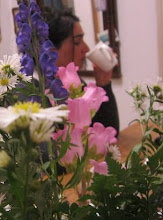Deep Mapping
"Reflecting eighteenth century antiquarian approaches to place, which included history, folklore, natural history and hearsay, the deep map attempts to record and represent the grain and patina of place through juxtapositions and interpenetrations of the historical and the contemporary, the political and the poetic, the discursive and the sensual; the conflation of oral testimony, anthology, memoir, biography, natural history and everything you might ever want to say about a place …"
Mike Pearson and Michael Shanks, Theatre/Archaeology - online publication (in pdf)
 Michael Shanks, Bamburgh, Northumberland
Deep map refers to an emerging practical method of intensive topographical exploration, popularised by author William Least Heat-Moon with his book PrairyErth: A Deep Map. (1991).
A deep map work most often takes the form of engaged documentary writing of literary quality; although it can equally well be done in long-form on radio and does not preclude the combination of writing with photography and illustration. Its subject is a particular place, usually quite small and limited, and usually rural.
Some call the approach 'vertical travel writing', while others compare it to the eclectic approaches of 18th & early 19th century antiquarian topographers or to the psychogeographic excursions of the early Situationist International.
However, a deep map goes beyond simple landscape/history-based topographical writing - to include and interweave autobiography, archeology, stories, memories, folklore, traces, reportage, weathers, interviews, natural history, science & intuition. In its best form, the resulting work arrives at a subtle, multilayered and 'deep' map of a small area of the earth.
In North America it is a method now often claimed by those interested in bioregionalism. The best known U.S. examples are Wallace Stegner's Wolf Willow (1962) and William Least Heat-Moon's PrairyErth (1991).
In Britain it is used by those who deploy the terms 'spirit of place' and 'local distinctiveness'. BBC Radio 4 has recently undertaken several series of radio documentaries that are deep maps. These are inspired by the 'sense of place' work of the Common Ground organisation.
Michael Shanks, Bamburgh, Northumberland
Deep map refers to an emerging practical method of intensive topographical exploration, popularised by author William Least Heat-Moon with his book PrairyErth: A Deep Map. (1991).
A deep map work most often takes the form of engaged documentary writing of literary quality; although it can equally well be done in long-form on radio and does not preclude the combination of writing with photography and illustration. Its subject is a particular place, usually quite small and limited, and usually rural.
Some call the approach 'vertical travel writing', while others compare it to the eclectic approaches of 18th & early 19th century antiquarian topographers or to the psychogeographic excursions of the early Situationist International.
However, a deep map goes beyond simple landscape/history-based topographical writing - to include and interweave autobiography, archeology, stories, memories, folklore, traces, reportage, weathers, interviews, natural history, science & intuition. In its best form, the resulting work arrives at a subtle, multilayered and 'deep' map of a small area of the earth.
In North America it is a method now often claimed by those interested in bioregionalism. The best known U.S. examples are Wallace Stegner's Wolf Willow (1962) and William Least Heat-Moon's PrairyErth (1991).
In Britain it is used by those who deploy the terms 'spirit of place' and 'local distinctiveness'. BBC Radio 4 has recently undertaken several series of radio documentaries that are deep maps. These are inspired by the 'sense of place' work of the Common Ground organisation.
 Michael Shanks, Dunstanburgh
more from chorography. more projects of Michael Shanks
Michael Shanks, Dunstanburgh
more from chorography. more projects of Michael Shanks





1 comment:
Lovely as always! I always read your posts with interest!i wanted to thank you for sharing all this wonderful information with the online community.
Post a Comment